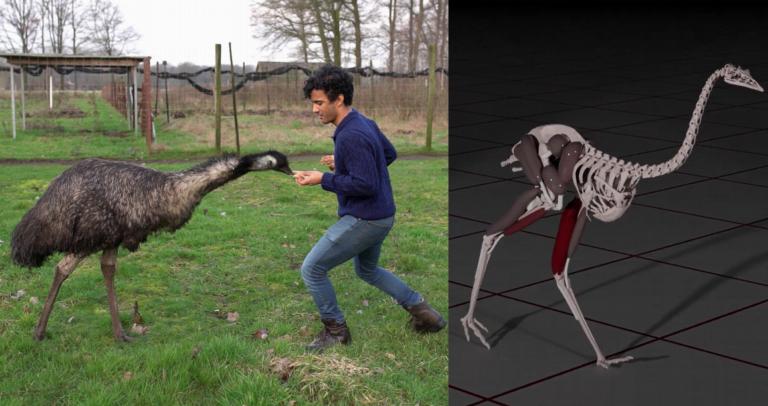
At first glance birds may not seem good runners. Try it yourself: bend your knees and run around on your toes while keeping at least one foot on the ground at all times. This feels unnatural to a human, but birds do this regularly. An international team led by researchers from Naturalis and Utrecht University have discovered why birds use this running style. “Maybe we should be teaching robots to run like this.”
Strangerunners
Birds use a strange running style. When humans run, there is always a moment where we do not touch the ground (an aerial phase). When birds run at intermediate speeds, they sometimes choose a running style where they keep at least one foot on the ground. This is known as “grounded running”. At first glance, this running style uses a lot more energy than running with an aerial phase. In general, animals evolved to move with as little energy cost as possible. If grounded running costs more energy, then why do birds do it? This question is called the “grounded running paradox”. A team of researchers from Naturalis Biodiversity Center and Utrecht University aimed to solve it.
Birdanatomy
It may not seem like it at first glance, but birds are very crouched. What we often mistake for their knees, are actually their ankles. The knee and hip joints are usually covered by feathers and not immediately visible. Their leg muscles also have long tendons that behave similarly to rubber bands: when these tendons are stretched, they store energy that is released later during the movement. These two factors are important to the running technique of birds. To resolve the grounded running paradox, you would have to isolate the effect of the tendons and the crouched position- but you can not do that with real birds.
The Ministryof Emu Walks
Using computer models you can separate the two. The team used physics based models of emus. They taught them how to walk, using an optimization technique also used in aerospace engineering: the model is optimized to move using the least amount of energy and muscle activations as possible. This sometimes produced funny results, as the models started running very weirdly in suboptimal movement coordinations. It also produced an important result: at certain speeds, grounded running is the optimal running style for emus and birds in general. Grounded running may be a less injury-prone running style. Previously, it was thought that birds pay for this increased safety with more energy. This new study shows that this is not the case: grounded running is the most economical running technique for crouched animals at certain speeds. The results are published in the journal Science Advances.
Dinosaursvs robots
Solving this paradox might give us clues about how dinosaurs may have run. “Birds inherited their anatomy from their dinosaur ancestors,” explains first author Pasha van Bijlert. “So the best way to learn about extinct dinosaurs is by looking at living dinosaurs”. This is not the only thing we can do with this information. “Grounded running is a more stable and smoother running style. Robots that walk on two legs are usually taught to run like humans. Grounded running is more energy efficient and better for the equipment, so maybe we should be teaching robots to run like this.“
Moreinformation
- The article called ‘Muscle-controlled physics simulations of bird locomotion resolve the grounded running paradox’ was published in Science Advances.
- A summary video can be found here
- Supporting images and film material can be found in this press kit. Credits are in the file names; please include them.
- For content-related questions, please contact first author Pasha van Bijlert through pasha.vanbijlert@naturalis.nl
- For general questions, please contact the Communications & Partnerships department of Naturalis through communicatie@naturalis.nl of 071 - 7519 648.